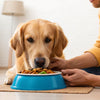How to Get Your Dog to Lose Weight Diet: A Comprehensive Guide for Pet Parents
- Houndsy
Table of Contents
- Introduction
- Understanding the Importance of Weight Management
- Crafting a Weight Loss Diet for Your Dog
- Incorporating Healthy Treats into the Diet
- Encouraging Exercise for Weight Loss
- Monitoring Progress and Adjusting the Plan
- Maintaining a Healthy Weight After Reaching Goals
- Conclusion
- FAQ
Introduction
Did you know that approximately 59% of dogs in the U.S. are considered overweight or obese? As pet parents, we often find ourselves torn between wanting to spoil our dogs and ensuring their health and well-being. The reality is that even a few extra pounds can lead to serious health issues, from diabetes to joint problems. As responsible dog owners, it's crucial for us to understand how to get our dogs to lose weight through diet and lifestyle changes.
In this blog post, we will explore the essential steps to help our furry friends shed those unwanted pounds. We will cover dietary guidelines, exercise routines, and practical tips to make the weight loss journey enjoyable for both us and our dogs. By the end of this guide, you will have a clear understanding of how to create a tailored weight loss plan that aligns with your dog's unique needs.
So, let's dig in and reflect on our own pet feeding routines while we explore effective strategies for a healthier, happier pup!
Understanding the Importance of Weight Management
Why Should Our Dogs Lose Weight?
Maintaining our dogs at a healthy weight is not just about aesthetics; it's about their health and longevity. Overweight dogs are at risk of developing a range of medical conditions, including:
- Diabetes: Excess weight can lead to insulin resistance.
- Arthritis: Carrying extra weight adds strain on joints.
- Heart Disease: Obesity can lead to cardiovascular problems.
- Respiratory Issues: Overweight dogs may have difficulty breathing.
- Shortened Lifespan: Studies show that overweight dogs tend to live shorter lives than their healthier counterparts.
By helping our dogs achieve and maintain a healthy weight, we can enhance their quality of life and potentially extend their years with us.
The Role of Diet in Weight Loss
When it comes to weight loss, caloric intake plays a fundamental role. The formula is simple: fewer calories in, more calories out. However, successfully implementing this formula requires a strategic approach to our dog's diet:
- Quality over Quantity: Choosing high-quality dog food that is low in calories but high in nutrients is essential.
- Portion Control: Accurately measuring food ensures our dogs receive the right amount for their weight loss goals.
- Treat Management: Understanding how treats fit into the overall caloric intake is crucial for successful dieting.
Crafting a Weight Loss Diet for Your Dog
Consult with Your Veterinarian
Before making any changes to our dog's diet, it’s imperative we consult with our veterinarian. They can assess our dog’s overall health, rule out any underlying conditions contributing to weight gain, and recommend a suitable weight loss plan tailored to our dog's individual needs.
Choosing the Right Dog Food
Not all dog foods are created equal. When selecting a diet for our dogs, we should look for:
- Weight Management Formulas: Many brands offer specially formulated weight loss diets that are lower in calories and fat but higher in fiber to keep our dogs feeling full.
- Veterinary-Approved Options: Consulting our vet can help us identify specific brands that meet our dog’s nutritional needs while promoting weight loss.
Implementing Portion Control
Portion control is vital in any weight loss journey. Here’s how we can effectively manage our dog's portions:
- Use a Kitchen Scale: Accurately measuring food using a scale or measuring cup helps prevent unintentional overfeeding.
- Follow Veterinary Recommendations: Our vet can provide a precise caloric intake based on our dog's weight, age, and activity level.
- Adjust Portions Gradually: If we need to reduce our dog's food intake, doing so gradually can help them adjust without feeling deprived.
Tracking Caloric Intake
Keeping a food diary can be a helpful tool in monitoring our dog's caloric intake. This allows us to:
- Record Daily Meals: Note what and how much we feed our dogs each day.
- Account for Treats: Keep track of any extra snacks to ensure they fit within the daily caloric limit.
- Evaluate Progress: Regularly weigh our dogs to see if they are losing weight as planned.
Incorporating Healthy Treats into the Diet
Treats are an essential part of our dog's life but can derail a weight loss plan if not managed properly. Here are some tips for healthy treat options:
- Choose Low-Calorie Treats: Look for treats specifically designed for weight management or consider using fruits and vegetables like carrots, green beans, or apple slices (without seeds) as healthier alternatives.
- Portion Control with Treats: As a rule of thumb, treats should make up no more than 10% of our dog's daily caloric intake. For example, if our dog requires 600 calories a day, then a maximum of 60 calories can come from treats.
Encouraging Exercise for Weight Loss
The Importance of Physical Activity
Exercise is a crucial component of any weight loss plan. Regular physical activity helps our dogs burn calories and maintain muscle mass. Here are some effective ways to incorporate exercise into our dog's routine:
- Daily Walks: Aim for 30 minutes of brisk walking every day. This not only helps with weight loss but also provides mental stimulation.
- Interactive Play: Engage our dogs in fun activities like fetch, tug-of-war, or agility training to keep them active and enthusiastic about exercise.
- Gradual Increases: If our dog is currently sedentary, start with short sessions of exercise and gradually increase the duration and intensity as they lose weight and gain stamina.
Making Exercise Fun
To keep our dogs motivated, we should make exercise enjoyable. Here are some ideas:
- Change the Scenery: Explore new walking routes or visit dog parks to keep things interesting.
- Incorporate Games: Use toys or balls to make exercise feel like playtime.
- Involve Family Members: Encourage the whole family to participate in walks or playtime, creating a bonding experience.
Monitoring Progress and Adjusting the Plan
Regular Check-Ins with the Veterinarian
As our dogs embark on their weight loss journey, regular veterinary check-ups are essential. These visits allow us to:
- Monitor Weight Loss: Weigh our dogs regularly to track their progress and make necessary adjustments to their diet or exercise regimen.
- Assess Health: Ensure that our dog is losing weight safely and healthily, without any adverse effects.
Making Necessary Adjustments
If our dog is not losing weight as expected, we may need to adjust their plan. Some factors to consider include:
- Caloric Intake: Reassess the number of calories our dog is consuming and adjust accordingly.
- Exercise Levels: Increase the frequency or intensity of exercise if our dog can handle it.
- Diet Quality: Consult with our vet to ensure the dog food we are using is still appropriate for weight loss.
Maintaining a Healthy Weight After Reaching Goals
Once our dogs reach their ideal weight, it’s essential to maintain that weight. Here are some strategies to help:
- Transition to Maintenance Diet: Work with our veterinarian to switch to a maintenance diet that will support our dog's new weight.
- Consistency is Key: Stick to a routine for meals and exercise, as dogs thrive on consistency.
- Keep Tracking: Continue to monitor our dog’s weight to catch any potential weight gain early.
Conclusion
In conclusion, helping our dogs lose weight is a journey that requires commitment, understanding, and collaboration with our veterinary team. By focusing on a well-balanced diet, portion control, healthy treats, and regular exercise, we can ensure our furry companions live longer, healthier lives. Remember, the goal is not only to achieve weight loss but to promote overall well-being and happiness throughout our dog's life.
As we embark on this journey together, let's keep our dogs' health at the forefront of our minds. If you're looking for a convenient way to measure and dispense your dog's food accurately, consider the Houndsy Kibble Dispenser. Its design allows for perfect portion control, making feeding time effortless and enjoyable!
FAQ
How much weight should my dog lose in a month?
Most experts recommend a safe weight loss of 1-2% of your dog's body weight per week, translating to about 3-5% per month. Consult your veterinarian to determine the best target for your dog.
Can I give my dog treats while on a diet?
Yes! However, treats should account for no more than 10% of your dog's daily caloric intake. Opt for low-calorie options or healthy fruits and vegetables as treats.
How often should I exercise my dog to promote weight loss?
Aim for at least 30 minutes of brisk walking daily, along with interactive play sessions several times a week. Gradually increase the duration and intensity as your dog gets fitter.
What if my dog isn't losing weight on their current diet?
If your dog isn't losing weight, consult your veterinarian. They can help you reassess your dog's caloric intake, exercise routine, and overall health to make necessary adjustments.
How do I know if my dog is overweight?
To check if your dog is at a healthy weight, feel their ribs. You should be able to feel them without too much pressure. Additionally, look for a noticeable waist when viewed from above and a slight tuck in the abdomen when viewed from the side. If you're uncertain, your veterinarian can perform a body condition score assessment.












